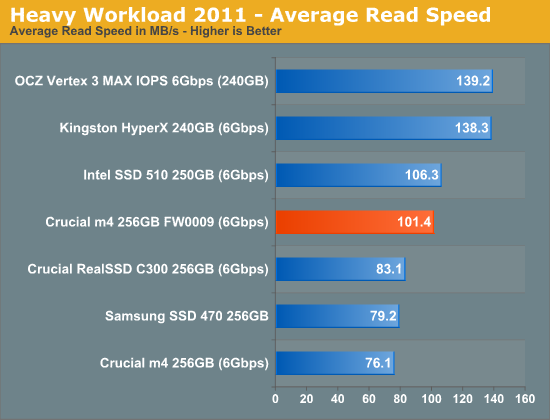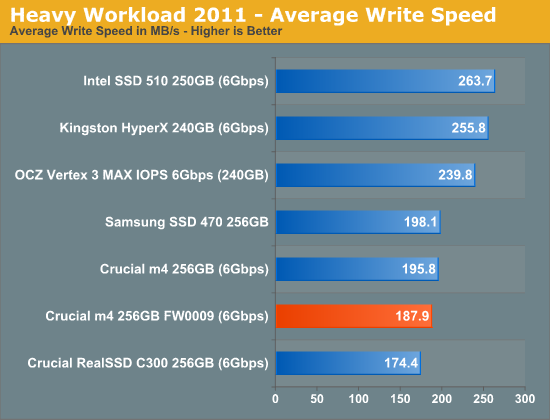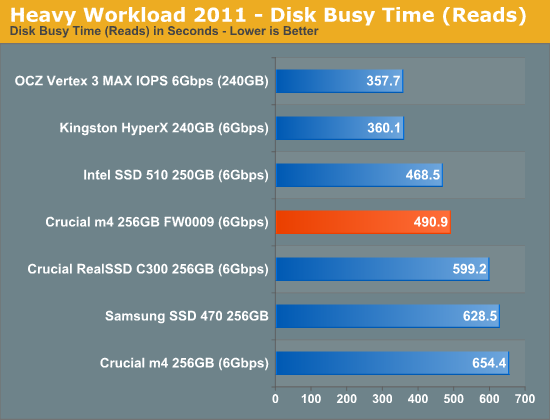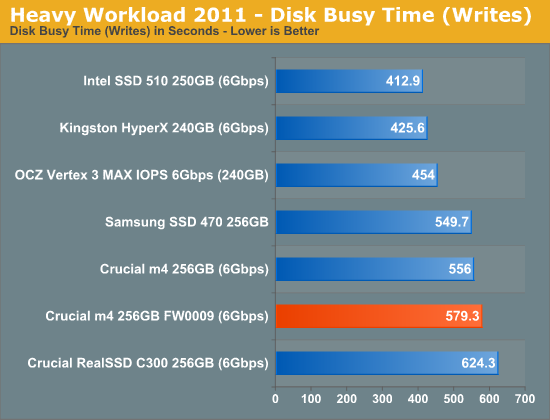The Crucial m4 SSD Update: Faster with FW0009
by Anand Lal Shimpi on August 31, 2011 12:56 AM ESTAnandTech Storage Bench 2011
Last year we introduced our AnandTech Storage Bench, a suite of benchmarks that took traces of real OS/application usage and played them back in a repeatable manner. I assembled the traces myself out of frustration with the majority of what we have today in terms of SSD benchmarks.
Although the AnandTech Storage Bench tests did a good job of characterizing SSD performance, they weren't stressful enough. All of the tests performed less than 10GB of reads/writes and typically involved only 4GB of writes specifically. That's not even enough exceed the spare area on most SSDs. Most canned SSD benchmarks don't even come close to writing a single gigabyte of data, but that doesn't mean that simply writing 4GB is acceptable.
Originally I kept the benchmarks short enough that they wouldn't be a burden to run (~30 minutes) but long enough that they were representative of what a power user might do with their system.
Not too long ago I tweeted that I had created what I referred to as the Mother of All SSD Benchmarks (MOASB). Rather than only writing 4GB of data to the drive, this benchmark writes 106.32GB. It's the load you'd put on a drive after nearly two weeks of constant usage. And it takes a *long* time to run.
1) The MOASB, officially called AnandTech Storage Bench 2011 - Heavy Workload, mainly focuses on the times when your I/O activity is the highest. There is a lot of downloading and application installing that happens during the course of this test. My thinking was that it's during application installs, file copies, downloading and multitasking with all of this that you can really notice performance differences between drives.
2) I tried to cover as many bases as possible with the software I incorporated into this test. There's a lot of photo editing in Photoshop, HTML editing in Dreamweaver, web browsing, game playing/level loading (Starcraft II & WoW are both a part of the test) as well as general use stuff (application installing, virus scanning). I included a large amount of email downloading, document creation and editing as well. To top it all off I even use Visual Studio 2008 to build Chromium during the test.
The test has 2,168,893 read operations and 1,783,447 write operations. The IO breakdown is as follows:
| AnandTech Storage Bench 2011 - Heavy Workload IO Breakdown | ||||
| IO Size | % of Total | |||
| 4KB | 28% | |||
| 16KB | 10% | |||
| 32KB | 10% | |||
| 64KB | 4% | |||
Only 42% of all operations are sequential, the rest range from pseudo to fully random (with most falling in the pseudo-random category). Average queue depth is 4.625 IOs, with 59% of operations taking place in an IO queue of 1.
Many of you have asked for a better way to really characterize performance. Simply looking at IOPS doesn't really say much. As a result I'm going to be presenting Storage Bench 2011 data in a slightly different way. We'll have performance represented as Average MB/s, with higher numbers being better. At the same time I'll be reporting how long the SSD was busy while running this test. These disk busy graphs will show you exactly how much time was shaved off by using a faster drive vs. a slower one during the course of this test. Finally, I will also break out performance into reads, writes and combined. The reason I do this is to help balance out the fact that this test is unusually write intensive, which can often hide the benefits of a drive with good read performance.
There's also a new light workload for 2011. This is a far more reasonable, typical every day use case benchmark. Lots of web browsing, photo editing (but with a greater focus on photo consumption), video playback as well as some application installs and gaming. This test isn't nearly as write intensive as the MOASB but it's still multiple times more write intensive than what we were running last year.
As always I don't believe that these two benchmarks alone are enough to characterize the performance of a drive, but hopefully along with the rest of our tests they will help provide a better idea.
The testbed for Storage Bench 2011 has changed as well. We're now using a Sandy Bridge platform with full 6Gbps support for these tests.
AnandTech Storage Bench 2011 - Heavy Workload
We'll start out by looking at average data rate throughout our new heavy workload test:

Overall performance in our heavy workload is now on par with last year's C300. We don't see huge gains in our heavy suite but Crucial has never really done well here to begin with. At least the numbers are up above the C300. The SF-2281 based Kingston HyperX has a 33% performance advantage here but if you look at the disk busy time below that amounts to around 4 minutes saved over hours of execution. In other words, you'd be hard pressed to tell the difference between nearly any of these drives.


The next three charts just represent the same data, but in a different manner. Instead of looking at average data rate, we're looking at how long the disk was busy for during this entire test. Note that disk busy time excludes any and all idles, this is just how long the SSD was busy doing something:













45 Comments
View All Comments
iwod - Wednesday, August 31, 2011 - link
I am one of the few,( or many ) who don't want a Sandforce based SSD and cant afford the Intel SSD. Crucial provides a very good balance SSD for a competitive price with m4. And the 0009 Firmware just sweeten the deal.landerf - Wednesday, August 31, 2011 - link
This drive has on a few occasions, and as recently as yesterday, had 15% codes at newegg. I got mine for $350 with one, and for a few days there you could get it as low as $333. Nuts deal for a drive that not only offers more usable space but none of that random BSOD shit you get with SF. Wait for another 15% off code, grab one, profit.Marlin1975 - Wednesday, August 31, 2011 - link
You always use intel for testing SSDs. How about compare a 950southbridge SATA 6gb to a Z68 Intel SATA 6gb?dac7nco - Wednesday, August 31, 2011 - link
That might be interesting; From what I've seen from some reviews, AMD's chipsets have improved their SATA-III throughput to a near-parity with Intel's... I don't remember specifics about random I/O.Daimon
zsero - Wednesday, August 31, 2011 - link
What is the Kingston HyperX drive in this test? Is it just me, who missed it? It is faster than EVERYTHING else, yet not a single article about it?DanNeely - Wednesday, August 31, 2011 - link
It's the representative SF-2281 SSD. Presumably it didn't get a full article because another SF2281 with identical flash chips had already been reviewed.http://www.anandtech.com/show/4390/kingstons-hyper...
Holly - Wednesday, August 31, 2011 - link
Running Vertex 3 on P67 chipset (ASUS board)... since firmware 09 release I had two hard locks requiring shut down computer (disconnect from UPS, wait, reconnect, run)... so the situation was much better... instead of few locks a day to one per month... given the machine runs 24/7.Installed firmware 11 today, curious if it solves the issue completely.
Other than that starting visual studio 2010 and opening project below 2 secs is just epic. Though as long as my machine runs without issues for 3 monts at least, I can't recommend the drive to any customer or friend.
gamoniac - Wednesday, August 31, 2011 - link
I saw on newegg that Crucial m4 SSD 128Gb is on newegg's Shell Shocker today, in case you plan on buying one.Nakecat - Wednesday, August 31, 2011 - link
I been doing some research regarding of C300 TRIM with RAID 0 or RAID 5, most of the answer i found are tell ing me that TRIM doesn't work in RAID Array even with TRIM OS. Is this true?MarkLuvsCS - Wednesday, August 31, 2011 - link
TRIM commands cannot be passed to a raid array. TRIM can be passed to drives on systems that have an nonraided SSD alongside raided standard drives (this has only happened a few months ago).Some drives do not require trim because they have an internal garbage collection built into the firmware such as the sandforce drives. Although Crucial has garbage collection as well, it does not occur aggressively to recover if the drive performance gets murdered by random writes. It WILL eventually recover its performance but TRIM makes sure this is never a problem.
Sandforce seems the only way to go for RAIDed drives but I would say you're better off buying a larger SSD to begin with to avoid these problems.